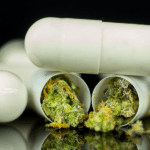A study recently published in the journal JAMA Network Open reported that secondhand cannabis smoke released from bong hits contains fine particulate matter at a concentration dangerously higher than secondhand smoke from tobacco cigarettes. This conclusion, which generated a lot of uncritical media coverage, was based on research conducted at the UC Berkeley School of Public Health. Project CBD asked cannabinoid scientist Matt Elmes, PhD, to review this study and assess the merits of its findings.
Project CBD: Is there much scientific data on the dangers of secondhand cannabis smoke?
Matt Elmes: Many clinical studies have demonstrated that long-term exposure to secondhand tobacco smoke has health hazards. To date, very few studies have been conducted assessing second-hand cannabis smoke. We don’t know whether or to what extent exposure to secondhand cannabis smoke is dangerous.
Smoke is mixture of gases and tiny particles of solid matter. Almost all gases are invisible to the naked eye, so what we are actually ‘seeing’ when we see smoke is many billions of tiny particles of solid matter. This particulate matter comes in various types and sizes, which mostly depends on the chemical composition of the material that you’re burning and the conditions of the combustion.
The recent JAMA Network Open study set out to measure solid particulates in air that are specifically <2.5µm (‘micrometers’ – one one-thousandth of a millimeter) in size. This is a common metric used when assessing air pollution or air quality. Airborne particles in this <2.5µm size range are able to travel deeply into our respiratory tract, and too much exposure has the potential to cause short-term health effects such as eye, throat, or lung irritation. Some studies have also suggested that long-term exposure can increase the risk of chronic bronchitis, cancer, or reduced lung function.
Project CBD: Are there any confounding factors that could skew the results of this study?
Elmes: For starters, this ‘bong paper’ is a simple observational study. It entailed a very ‘hands-off’ approach that was probably used to circumvent human research requirements. The researchers were not able to interact with the participants in any way, not even to give them any instructions or guidance! Participants all provided their own weed, their own bong, their own experimental conditions in their own home. This sort of study design is far from ideal and greatly limits our ability to draw many concrete conclusions.
To elaborate, the study design was probably selected as a workaround due to the researchers not being able to legally run a properly controlled study because of the illicit Schedule I status of cannabis. Research groups that have any federal grant funding (as do the vast majority of academic research groups) cannot directly study Schedule I drugs without jumping through significant regulatory hurdles. It’s also worth noting that this is technically not a human study. The need for IRB [Institutional Review Board] approval was waived here. This means that the researchers were extremely limited in what they could study, their recruitment procedures, and how they could interact with the participants.
Project CBD: The paper states: “Several smokers smoked at their own volition, ad libitum, in a social setting of their own choosing, not an experimental setting, and without any instructions or limitations from the investigators.” What are we to make of this?
Elmes: I think the problem here speaks for itself! Totally uncontrolled and we know next-to-nothing about the conditions in which these measurements were performed. Since the participants smoked “in a social setting of their own choosing” and were not given any other instructions, it seems likely that the smoke generated from a single person smoking a bong wasn’t the only thing detected. There could have been several friends in the same room who were also hitting the bong, which would not be unusual. This would seem to be at odds with the air quality studies set up in a single tobacco smoker’s home.
Project CBD: Does it make sense to directly compare the data from this study to what’s known about the particulate matter in secondhand tobacco smoke?
Elmes: It’s not really a fair comparison due to the many stark differences in how the studies were conducted and their uncontrolled nature. The tobacco studies were conducted in dissimilar environments and sometimes differ in the devices used to measure air particulates. The cited tobacco papers also show a lot of variances in their air quality data as evidenced by large standard deviation values.
There are also key differences in the manner that bongs and cigarettes are typically smoked. Cigarettes usually involve lots of small puffs throughout the day, whereas smoking a bong is notorious for large billowy hits within a smaller timeframe. Comparing tobacco cigarettes to cannabis joints would seem to be a bit more apt.
It’s not controversial to suggest that the smell from cigarette smoke tends to ‘stick’ to a room much more than cannabis smoke. Cigarette smokers in homes are often made to smoke outside or near an open window. Air flow is a critical determinant in how quickly smoke will clear from a room, and we have absolutely no idea how drafty or unventilated the rooms they smoked in were. However, the Methods section of this bong paper states that “all windows and doors were observed to be closed for each [bong smoking] session.” It seems unlikely that the participants of the comparative second-hand tobacco smoke studies would be similarly ‘hot-boxing’ their living rooms with cigarettes. We cannot comparatively assess air particulate data without knowing whether the cigarettes and bongs were smoked in similarly ventilated areas or not. It’s one of many conditions that were simply not controlled for in this study. We don’t even know if cigarettes were also smoked in the same room where the boys were hitting the bong!
Project CBD: What about recruitment biases? How were the test subjects chosen for the bong study?
Elmes: The paper provides no details about how the researchers were permitted to run recruitment for a ‘non-human’ study. I think that a young person who prefer bongs is in general the more heavy-smoking, stereotypical sort of pothead. We know next-to-nothing about how this experiment was run, nor do the experimenters apparently since the participants were not directly observed or even provided with any instructions.
Project CBD: Were the bongs clean and how much was smoked?
Elmes: Looks like they probably were not clean since participants provided their own glassware. Any seasoned pot-smoker knows that resin rapidly builds up in glassware. Is some of the particulate matter being detected actually from past smoke sessions? Smoking from a dirty bowl feels harsher on the throat, so there are likely chemical differences between smoking just cannabis versus reheating cannabis tar.
The supplemental methods section of the paper indicates that “5-8 bowls were smoked per [bong] session.” But the experimenters do not actually know how much cannabis was smoked. I’d say that a small bowl probably contains about 0.1g cannabis, and a large bowl has more like 0.8g. This gives us an extremely wide potential range of ~0.5g-6.5g of cannabis smoked per session. However, it’s worth noting that the average tobacco smoker typically burns much more plant matter than a cannabis smoker. One tobacco cigarette equals 1 gram of tobacco. So, a pack-a-day smoker is smoking 20g of plant matter per day. Even heavy potheads don’t smoke this much cannabis.
Project CBD: So, what conclusions can be drawn from this?
Elmes: Despite the high safety profile of cannabis, smoking it is not without risks. Inhaling lots of combusted plant matter is not healthy no matter what plant it is. However, to my mind, the single biggest public health concern regarding exposure to second-hand tobacco smoke is the well-documented neck, throat, and lung cancer risk. This shouldn’t be much of a concern with second-hand cannabis smoke considering that cannabis smoke and tobacco smoke are not equally carcinogenic. While the verdict may still be out over whether cannabis has the potential to be clinically helpful in the treatment of certain cancers, we already have sufficient evidence to reasonably conclude that cannabis is at least not causing these cancers. If a lifetime of firsthand cannabis smoke does not correlate to development of head, throat, neck or lung cancers, then I think there is little reason to believe that secondhand exposure to cannabis smoke has this potential.
Perhaps cannabis does produce more <2.5µm particulate matter than tobacco. I’m not necessarily convinced of that conclusion from this paper, but their data does point in that direction and it is certainly possible. At face-value this would appear to be less healthy, but it’s not necessarily so. The size of the airborne particles is not the sole determinant of health outcomes, their composition also matters. One should be wary of over-interpreting data from a ‘non-human’ observational study like this and linking it to health effects. Simply measuring airborne particles near an unknown number of people smoking a bong is nowhere near sufficient to draw any clinical conclusions whatsoever!
Dr. Matt Elmes is a cannabinoid scientist and cannabis enthusiast. His professional background spans both academia and industry. He currently works as a freelance consultant for biopharmaceutical and cannabis companies. © Copyright, Project CBD. May not be reprinted without permission.
Recommended Readings
Hit & Run: Impaired Science
A flawed study by Harvard scientists claims that marijuana impairs driving even when users aren’t high.
Data Distortion: Use & Abuse of Cannabis Science
Misinformation can masquerade as science, especially when it comes to cannabis. Learn how to spot faulty research.
Hooked on Weed? Try Nicotine Instead
Another hare-brained idea about cannabis replacement therapy from NIDA.










